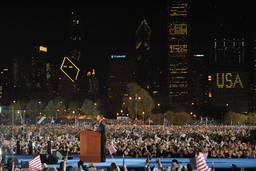Katrina Through Rose-Colored Glasses
Race does matter in the caustic caldron of the post-Katrina era--the world still perceives us as “refugees”--permanently scarred victims to be forever adrift in tragedy
Laura S. Washington
History is written by the powerful and the articulate. Chris Rose, a columnist for New Orleans’ Times-Picayune, has painted a powerful and articulate historical landscape in his book 1 Dead in Attic.
His canvas is post-Katrina New Orleans. His palette is the absurdities and horrors of a town with its entrails splattered on the sidewalk in the midst of a heat wave.
It’s not a pretty picture.
The book is a memoir of sorts, written in episodic fashion. Each chapter comes from columns Rose wrote in Katrina’s aftermath. His topics range from the role of refrigerators as a gauge of public civility to his outrage at the outsiders he calls “racial jihadists – of both colors who think that murder is what this city is about.”
Rose, who is white, echoes Rodney King’s plea, “Why can’t we all just get along?,” arguing that racial exceptionalism undermines New Orleans’ ability to heal.
Such simplistic notions are suspect. If you’ll excuse the pun, Rose’s perspective on race is viewed through rose-colored glasses. Whites like to think their culture and experiences are universal. People of color might beg to differ.
The racial tableau that Katrina wrought is far more complex. Katrina engulfed the entire Gulf Coast and left behind fear, resentment and despair from the seaside enclaves of the predominantly white Mississippi coast to the apartments of Vietnamese immigrant families in East New Orleans.
Race does matter in the caustic caldron of the post-Katrina era. The world still perceives us as “refugees” – permanently scarred victims to be forever adrift in tragedy. There is much, much more to the story, and I yearn to see a black writer bring it on with a thoughtful and nuanced portrait.
Still, Rose’s reporter’s eye for surreal details and sharp edges makes 1 Dead a page-turner. His credo for other New Orleanians: “When life gives you lemons – make daiquiris.”
Rose’s tale is a rip-roaring sprint through a garden of broken and discarded junk. The characters are a mixture of the profane and saintly. The people in charge, the so-called “authorities,” are benign at best, nonexistent at worst.
In one story, Rose is out on a reporting expedition in the Garden District when he suddenly faints by the side of the street in broad daylight. He lies there for four hours. He is totally ignored.
He meets cat ladies with ethereal demeanors, survives encounters with tripped-out New Orleanians and has an epiphany at the New Orleans Superdome. In the latter, Rose flung himself into a drunken, delirious crowd, reveling in the New Orleans Saints 23-3 victory in a Monday Night Football game – the first Superdome contest since the disaster.
“There is something about waking up in a community that is thinking the same thing,” Rose reflected, “that is feeling – if only for a moment – as if we had accomplished something together – when actually it was a bunch of millionaires whose names we hardly know.”
It breaks your back, but you read on.
Refrigerators loom large. This most ordinary of kitchen appliances becomes the barometer of an individual’s humanity. “Refrigerators are poignant symbols of our city’s destruction and our government’s inertia; many are now painted with political slogans. The refrigerators of New Orleans are also the weapons of choice in the rapid deterioration of civility Uptown. Weapons of our mass destruction – literally.”
When Katrina hit, refrigerators and their contents were swallowed by the rising floodwaters. Weeks later, when the water receded, the toxic stench boggles the imagination. What to do with thousands of reeking, contaminated refrigerators? It was no longer an existential question, but a personal, in-your-face decision.
“Refrigerator clusters have started appearing all over the area, as one guy dumps his fridge on a corner away from his house, and then – like iron shavings drawn to a magnet – suddenly there are five appliances on the corner, then 10, then 15.”
The landscape, littered with the acrid odors of the refrigerators’ private parts, became the smell track to the Katrina story. It ain’t Chanel No. 5.
The psychological state of the entire city is in question, Rose writes. “Everybody’s got it, this thing, this affliction, this affinity for forgetfulness, absent-mindedness, confusion, laughing in inappropriate circumstances, crying when the wrong song comes on the radio, behaving in odd and contrary ways.”
No wonder everyone here is “mentally ill,” he writes. “How could you not be? Consider the sights, sounds and smell you encounter on a daily basis as you drive around a town that has a permanent bathtub ring around it. I mean, could somebody please erase that brown line?”
The Katrina story may have been told a thousand times. Yet when you read Chris Rose’s 1 Dead in Attic, you are drinking some mighty strong coffee-and-chicory.

I hope you found this article important. Before you leave, I want to ask you to consider supporting our work with a donation. In These Times needs readers like you to help sustain our mission. We don’t depend on—or want—corporate advertising or deep-pocketed billionaires to fund our journalism. We’re supported by you, the reader, so we can focus on covering the issues that matter most to the progressive movement without fear or compromise.
Our work isn’t hidden behind a paywall because of people like you who support our journalism. We want to keep it that way. If you value the work we do and the movements we cover, please consider donating to In These Times.







